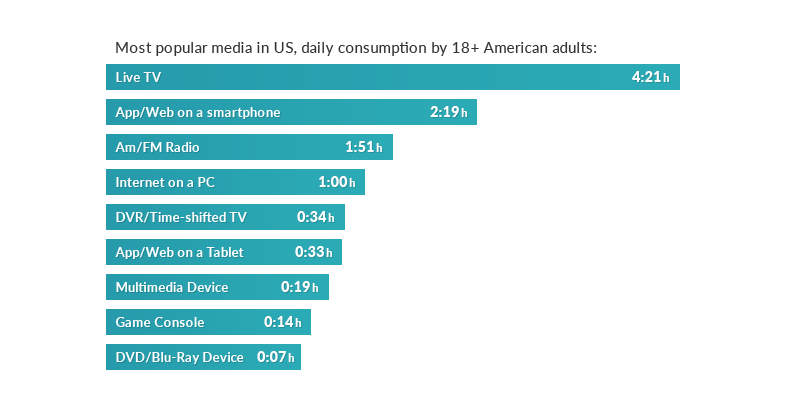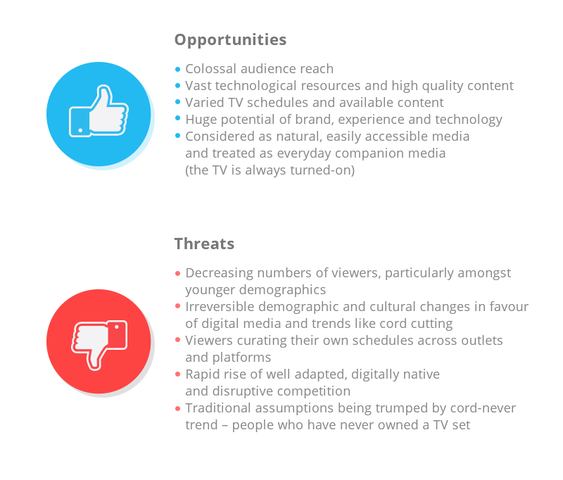Your essential read if you’ve ever wondered how to make traditional TV cool again!
In the US, adults are spending more and more time with different kinds of digital media[1], while their attention is also shifting from traditional TV to PCs, and smartphones and tablets connected to the web.
What’s interesting is that while there is an enormous variety of traditionally broadcast TV channels to choose from (a monthly average of 206 channels according to Nielsen research), US adults only actively watch 20 of them[2]. In other Nielsen data for US adults, while TV still rules people are using a broader range of devices for home entertainment, with apps and the web now hot on the heels of TV. The total time spent on other devices now outweighs time spent watching traditional TV.

If you look at the behaviour of younger viewers in particular, what’s evident is that Generation Z (12-20 year olds) consume the smallest amount of traditional TV, either when live or time shifted/recorded. Arguably, this is the effect of a new and younger audience becoming bored (or simply not accustomed to) traditional TV’s linear approach, which might be a challenging argument to accept if you work in broadcast TV.
To help you to understand, let’s look at this analogy. Nowadays, traditional TV is like a middle-aged guy trying to gain popularity on Snapchat – the technology feels the same, the rules are clear, but somehow it simply doesn’t work for him. What he says and does is simply not attractive enough for the audience on that platform. (Believe me, I feel like this guy at times as I don’t always understand the buzz surrounding Snapchat.)
Back in the broadcasting world, you may be more than conscious that new ways of consuming media are coming. You might feel they’re already here. Yet, with huge resources, varied schedules and all the broadcasting technology at your disposal, perhaps you’re still left wondering why traditional TV isn’t as attractive as it was? Perhaps you can’t quite put your finger on why this is the case.
Let’s take a closer look at some of the opportunities and threats below.

What’s common amongst the above threats is the impact of the internet and the smartphone. Viewers now have more flexibility – they can watch and interact with digital, web TV and OTTs in any manner they like, where and when they want, and on the device of their choosing.
Why should viewers miss the ol’ set-top box? So, is this the end of linear TV as we know it? It’s too early to jump to this kind of conclusion. For sure, there are now many more options to traditional TV and improvements that linear broadcasters should make to stay in the game.
Let’s dive in and check out six ways you can sharpen your focus to stay alive in this fast-paced, digital-first world.
- Make the web your friend and ally
- Use your TV brand as leverage
- Your experience is your advantage
- Retain your loyal viewers
- Work across platforms
- Conversations – it takes (at least) two to tango!
First things first, if you haven’t done so already, make your brand more visible online by expanding your social media presence. Take time to reconsider your options, making an audit of your efforts to date to identify what’s worked and what hasn’t.
When relaunching your social media presence, have a video content strategy in place that puts you in a position to start streaming and producing videos for social channels. Streams and social videos make for highly engaging web content and, as a broadcaster, you are ideally placed to create a constant stream of such content. To do so, choose social video production tools and platforms that will fit your needs, and ones that will enable you to stream and produce videos from live content and any archival content you want to use.

Live streams and videos are undoubtedly the most engaging types of content. When checking Facebook streaming results for one of our Tellyo clients, we learned that it is possible to create up to 400 interactions per 1,000 fans with live video, while images were able to reach only 6 interactions per 1,000. For further interesting stats, check out the case studies section on our website.
Having a strong and recognisable brand is unbelievably helpful online – it will help you to stand out. If your logo is well known, you should remember to place it on your video content, so that when this spreads around the internet you get the brand recognition you deserve. With a little bit of luck, many viewers will trace your quality content back to your channel or Facebook page.
Being experienced with video production and everything broadcasting related is a huge advantage over your competitors. Being able to create TV-grade video content, while having an experienced team and professional equipment are all strong assets. However, these assets aren’t enough to be successful on the web and in the social media, but they will help a lot. You can always talk to us here at Tellyo about how to combine your experience with an advanced, social video production platform such as ours.
Have you ever heard of the Pareto principle[4]? Better known as the 80/20 rule which states that 80% of the effects come from 20% of the causes. Translating this into broadcast language – it means that 20% of your audience is responsible for 80% of your views. Therefore, if you want to be successful in social media, play to your core audience. Let them know that soon they will be able to watch their favourite shows and events via other media as well.
Remember that social media isn’t monolithic – it’s decentralised and each platform has its own properties. You shouldn’t copy and paste your strategy from one channel to another. For example, if you decide to stream content then use YouTube, Facebook or Twitter, but only YouTube will be a good place as a platform to host clips for a longer period. Facebook will give you a big audience and visibility initially, but people will not find your videos once they vanish from timelines.
Your audience has a voice, and it will use it. In comments, emails and chats, they will use each possible channel to give you their opinion about your content. And that’s a good thing – a gold mine of interactions and engagement to treasure. You should work hard to maintain these conversations. Be active: answer questions and ask for opinions.
It’s too early to abandon ship
Traditional, linear TV still has a lot to offer audiences. But the TV landscape in the next 5-10 years will be dramatically different to what we have now.
In the meantime, there is likely to be many more advances and disruptive changes. Now is your chance to decide whether you want to be part of it or not.
Everything you’d like to know about video streaming, but were afraid to ask
If you are just about to start your adventure with professional live video streaming, you may well be a little bit confused. Whether you’re a social media specialist or digital marketer or you’re working in sport, fashion or the music business, streaming will undoubtedly improve your content, brand visibility and boost sales. But there’s a plethora of things you need to remember, learn and tons of options to choose from. Let’s start with the basics and answer some of the most commonly asked questions regarding live video streaming.
What are the best ways to livestream an event and why?
There are many free solutions if you want to stream an event, which you can easily check out for yourself. For personal use, the free solutions can be great. But if you aspire to professional streaming of any kind, the free options aren’t going to offer you enough.
Free software solutions for live video streaming (whether an online or desktop solution) are either not advanced enough or simply not good enough. When using a free solution it is quite common to encounter problems during a livestream and highly likely you will not be able to get support when it comes to technical issues.
If you aim to create great live streamed content and promote your event effectively, you should put in place specialist software that will enable you to better configure and manage your stream.
Professional quality never comes for free!
In answering the question, to stream your event in the best possible way, use professional tools to guarantee great results.
What is the best software for live video streaming?
Here at Tellyo, we’ve put a lot of expertise into creating our streaming software. We’re confident it is one of the best professional solutions for streaming regardless of the event type – be it a sports match, fashion show or music gig. Why?
Specifically designed for streaming and clipping videos, our software platform enables you to edit your content and its audio, and adjust videos to fit different formats and streaming destinations (such as Facebook and YouTube).
Tellyo is cloud-based software built on a core platform that delivers two separate solutions to choose from: Tellyo Pro for extensive usage when you have lots to live stream; plus Tellyo On Demand for occasional streams and when you want no strings and simple payments. Both are fully professional solutions and support the most popular social media channels like Facebook, YouTube, Twitter, and Periscope.
You can request Tellyo Pro demo here (we will require some technical details from you) or simply create your account in Tellyo On Demand and start streaming.
What are some of the best live video broadcasting sites to stream live events?
If you want to stream to social media using a channel that’s already popular in the market, there are quite a few streaming-friendly sites we can highlight:
- YouTube
- Periscope
What’s great about the above platforms is that they not only offer streaming features, but also include other cool features too, like chat (YouTube) or announcements and sponsored posts (Facebook). However, the most important part of the deal is that popular social media channels offer direct contact with audiences on pre-established platforms.
Is it possible to live stream to Facebook, YouTube and Twitter simultaneously?
Yes. You can stream to all of the above mentioned platforms simultaneously using Tellyo. Additionally, you can broadcast to other, custom RTMP destinations.
What are some KPIs for live streaming?
This will very much depend on your strategic objectives. If you wish to gain audience and brand visibility, you should aim to get as many viewers and views as possible. Total reach is also a valuable indicator because it shows how many people could have potentially viewed your content.
Depending on your needs, other indicators might include engagement signals (likes, comments and shares), leads and sales, or new signups to on-demand platforms.
It is crucial to set some goals before you start a stream, as these will give you something to measure against.
What are the best practices for live streaming events?
We’ve prepared a number of articles that you might find useful, regardless of your streaming experience or industry knowledge:
- Improve your social broadcasts with different content types
- 8 common live streaming mistakes
- What indicates success? The social video KPIs that count
- Going social with your broadcast: the basics
- Sports video content ideas to help you survive out of season
- How to prepare and promo live-streamed sports content?
- How to incorporate sponsorship into your real-time social videos
- How to turn broadcast content into great social live streams
- Three ways to maximise real-time interactions with fans
- Understanding the power of online sports videos
- A sport marketer’s simple guide to Facebook post promotion
Explore our blog for other interesting insights and ideas.
Is it possible to clip videos out of a live stream?
Using Tellyo – yes. Our platform allows you to cut clips out of live streams and simultaneously share them on social media in a matter of seconds. You can enhance your clips using our feature-packed Editor or simply clip-and-publish. Videos can be distributed straight from the Editor to the most popular social platforms of your choice. If video editing and live streaming is your main concern – consider using Tellyo.
What kind of events can be turned into live video streams?
There’s really no correct answer to this. However, if you’re responsible for an event and it would benefit from having a larger audience, or you want to reach people who are unable to attend in person, then it would be a good option to stream.
To understand what kind of events others are streaming, let’s take a look at some of our clients:
Our Tellyo Pro is used mainly by sports leagues and federations, and TV and digital broadcasters. They will own content or have the rights to stream it, so they require a trusted service that will enable them to broadcast their content directly to social media. They stream big amounts of content regularly, such as entire matches and complete shows.
Tellyo On Demand is used across sport, fashion, music and event organising. It offers a more flexible option and is suitable for organisations who only need to stream from time to time, but still want to rely on an excellent service. They stream small amounts of content, such as occasional behind-the-scenes footage, gigs, press conferences, and fashion shows.
Still not convinced?
If you still have some doubts regarding live video streaming, live production, real time video sharing or anything in between – let us know. Send in your question(s) using our form, message us at contact@tellyo.com, or make contact via social media.




